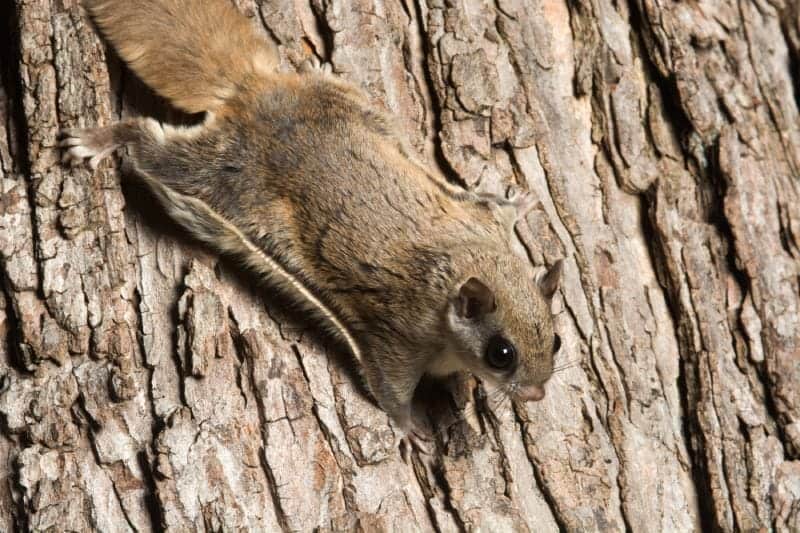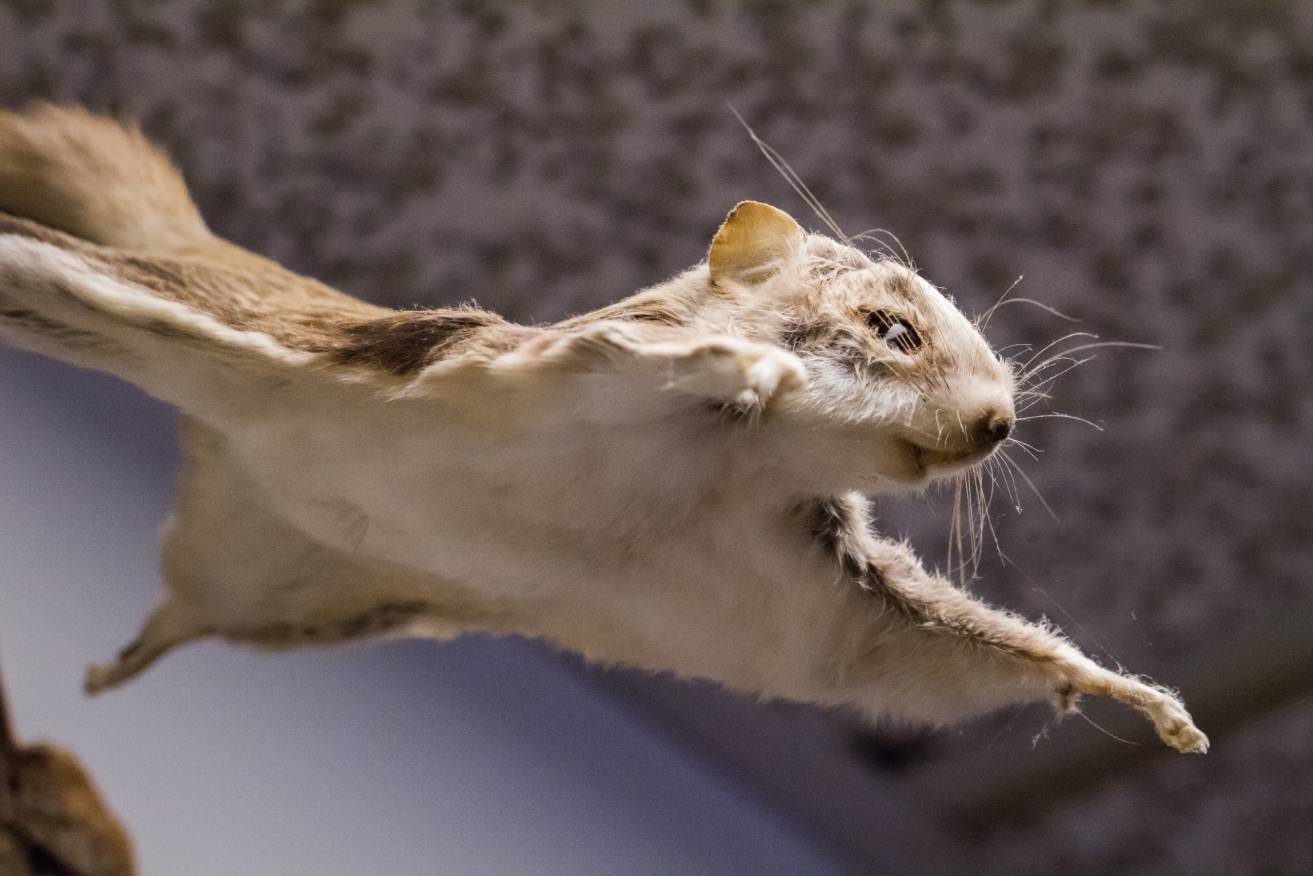Flying squirrels are interesting creatures that form part of a tribe of over 50 species of squirrels in the Sciuridae family. These animals are unable to fly like bats or birds, but they can glide across an impressive distance. This allows them to quickly escape predators, move from trees with ease, and catch their prey. Flying squirrels are a rare type of exotic pet and not many people know that these creatures have even been tamed in captivity. Interestingly, flying squirrels are becoming popular pets for people who work in animal rehabilitation centers. During storms and other accidents, flying squirrels are taken into these centers for rehabilitation purposes, however, some are not allowed to be released back into the wild and are cared for by a wildlife worker.
The diet of the flying squirrel is slightly complicated. In the wild, they will consume foods like seeds, nuts, fruits, fungi, and various types of insects. There are many aspects to follow to ensure they are receiving the appropriate amount of nutrients to remain healthy. If you are interested in learning how to provide your flying squirrel with the proper types of foods, then this article is perfect for you!

All You Need to Know About Flying Squirrels
There are two species of flying squirrels, the Northern (Glaucomys sabrinus) and the Southern (Glaucomys Volans) squirrel. These are the only flying squirrels that are native to North America.
The Northern flying squirrel has a belly with a grey base, whereas the Southern flying squirrel has a cream-colored belly. This is the only distinctive way to tell the difference between these two species because they are both brown, grey. The Southern species grows to an adult size of 8 to 10 inches in length, and the Northern species reaches between 10 to 12 inches in size.
Flying squirrels have a membrane between the front and back of their legs. When they want to move to a different area nearby, they jump high into the air and spread their limbs to glide in the air. They cannot flap their wings or fly which is why they are also known as ‘gliding’ squirrels which is a more appropriate name.
The legs steer the squirrel in the air, and they also use it to break when they have reached their destination.
Fun fact: A flying squirrel can cover 150 feet in a single glide. Now that’s impressive!

Flying Squirrels as Pets (Laws & Regulations)
People have been keeping flying squirrels in captivity for decades, but it is important that the ownership of these creatures is regulated and permitted to live in captivity by a certified wildlife conservation center in your region. Due to their exotic label, they are illegal to be kept as pets in many different states. Keep in mind that some states ban the keeping of extreme exotic pets, while others require you to have a permit or license to own them. It is also illegal to purchase a flying squirrel from unsupervised market sites. This opens a world of illegal wildlife trading, and the squirrel has most likely been captured from the wild.
If you do want to source a flying squirrel as a pet, be sure to check with local wildlife conservation centers to see if they have any squirrels who need permanent homes since most of them are not allowed to be released back into nature either because of the extent of their injuries, or they have been in contact with humans for too long.
Two subspecies of the Northern flying squirrel are federally listed as endangered due to habitat loss from human intervention.

What Do Flying Squirrels Eat in The Wild?
Flying squirrels are natural omnivores. In the wild, they will consume foods like seeds, nuts, fruits, fungi, and various types of insects. This provides them with all the nutrients they require to grow, develop, and maintain a healthy immune system.
According to the National Wildlife Federation, the Southern species of flying squirrels are closer to being carnivores than omnivores. This species consumes supplements like eggs, carrion, and small birds. They have interesting hunting abilities and gliding helps them to silently catch their prey.
These creatures live in coniferous and deciduous forests and various woodlands. They take shelter in old nest boxes by other squirrels and birds, woodpecker holes, or in snags. They spend most of their time high up in thick-leaved trees. In winter, flying squirrels will nest with other squirrels to keep warm and feel secure. Due to their impeccable escaping abilities, they can outsmart and escape various predators like hawks, owls, or tree snakes.
The Southern flying squirrel can catch small mammals like rodents with ease that inhabit the vegetation and woodlands below trees.
What Do Flying Squirrels Eat in Captivity?

It is tricky to find the perfect diet for flying squirrels in captivity. Most of their diet should be provided from wildlife conservation, and they will explain how to gain access to their captive foods and how to feed them to your pet flying squirrel.
Young flying squirrels (kits) are the most common type of squirrel given to rehabilitation centers. Volunteers may take these babies home to care for and feed them. However, their diet differs from adults.
- Kits: these young flying squirrels are not weaned until 6 to 8 weeks of age. They should be fed high-quality puppy or goat replacement milk found in pet stores. This should be fed through a syringe or eyedropper three or five times a day depending on the condition you get them in. They should not be fed solid foods until they are fully weaned. The most important source of food for kits is their mother milk, but orphaned kits will need your help in feeding.
- Juveniles: when they reach to be 8 weeks, they are known as juveniles. They should be slowly weaned from goat or puppy milk replacement and the time between feeding can be reduced. You can then start feeding them fruits and small insects.
- Adults: Once they are fully grown and have reached adulthood, they can be fed various foods like boiled chicken eggs, larger insects, safe mushrooms, pieces of fowl, and premium flying squirrel mixes sold from wildlife centers or online, but this should be fed alongside various supplements and should not be fed on its own. They do not require milk replacements at this age, and they should always have constant access to fresh bottled water.

Conclusion
Flying squirrels can make good pets for the right household. If you are interested in owning or volunteering to rehabilitate a flying squirrel, then it is recommended to write out a meal plan that should be checked over by a wildlife specialist or veterinarian to ensure that the foods are going to be healthy as a long-term diet.
They have a lot of personalities and require the right type of environment and enrichment to keep them healthy and happy. Feeding forms an important part of caring for your flying squirrel, but the enclosure and its layout are equally important.
Interesting Thoughts:
- What Do Squirrels Eat?
- How to Tell the Age of a Baby Squirrel (With Pictures)
- How to Take Care of a Baby Squirrel (Care Sheet Guide)
Featured Image Credit: Laura Fiorillo, Shutterstock
